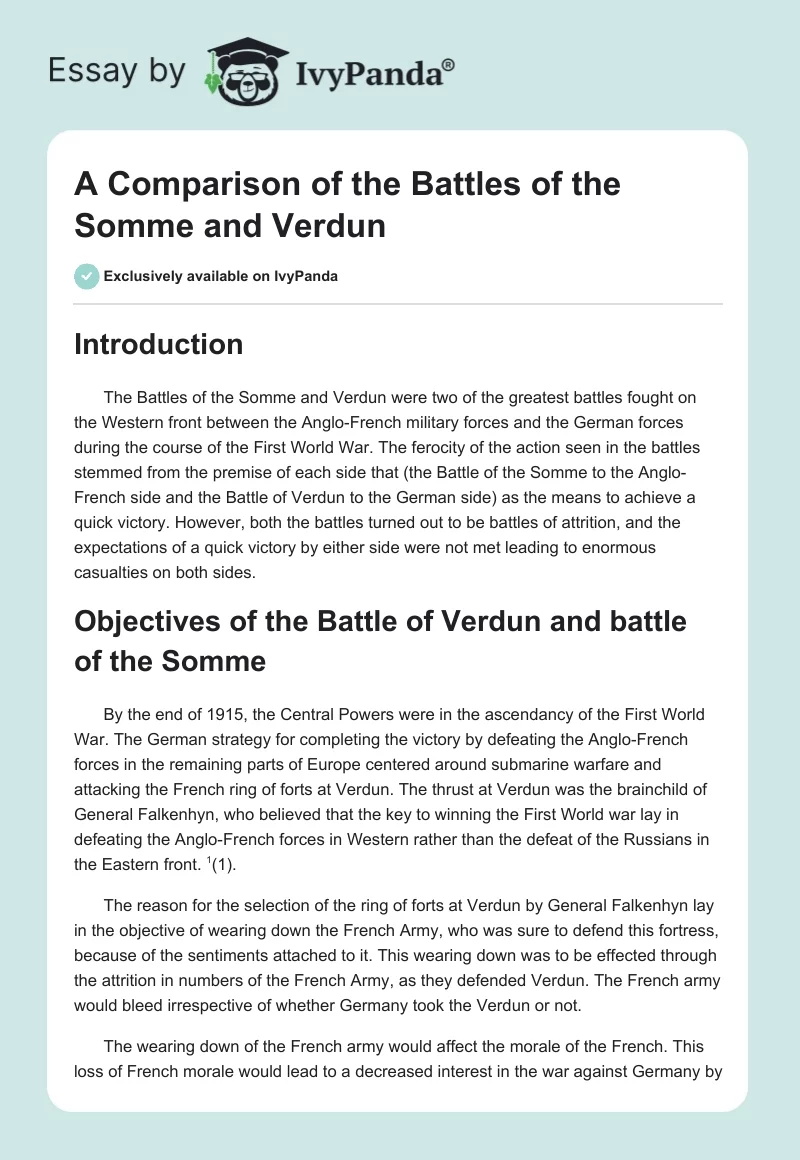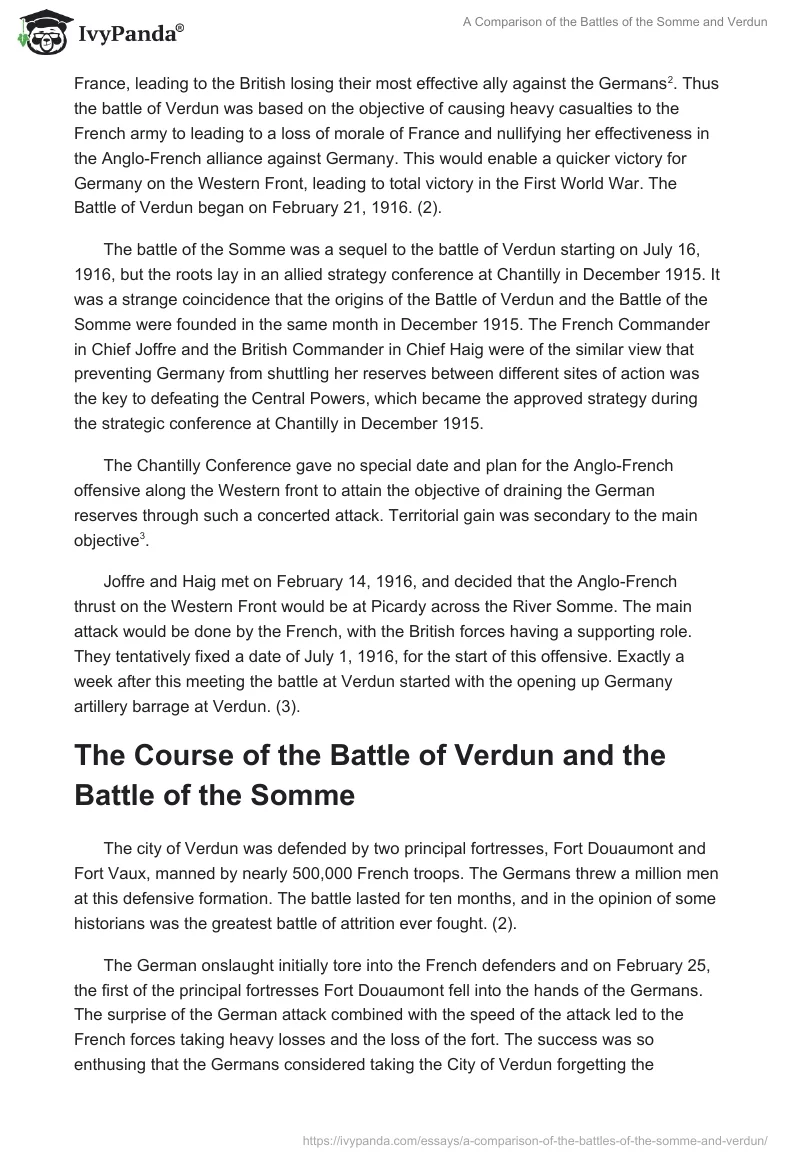Introduction
The Battles of the Somme and Verdun were two of the greatest battles fought on the Western front between the Anglo-French military forces and the German forces during the course of the First World War. The ferocity of the action seen in the battles stemmed from the premise of each side that (the Battle of the Somme to the Anglo-French side and the Battle of Verdun to the German side) as the means to achieve a quick victory. However, both the battles turned out to be battles of attrition, and the expectations of a quick victory by either side were not met leading to enormous casualties on both sides.
Objectives of the Battle of Verdun and battle of the Somme
By the end of 1915, the Central Powers were in the ascendancy of the First World War. The German strategy for completing the victory by defeating the Anglo-French forces in the remaining parts of Europe centered around submarine warfare and attacking the French ring of forts at Verdun. The thrust at Verdun was the brainchild of General Falkenhyn, who believed that the key to winning the First World war lay in defeating the Anglo-French forces in Western rather than the defeat of the Russians in the Eastern front.
The reason for the selection of the ring of forts at Verdun by General Falkenhyn lay in the objective of wearing down the French Army, who was sure to defend this fortress, because of the sentiments attached to it. This wearing down was to be effected through the attrition in numbers of the French Army, as they defended Verdun. The French army would bleed irrespective of whether Germany took the Verdun or not.
The wearing down of the French army would affect the morale of the French. This loss of French morale would lead to a decreased interest in the war against Germany by France, leading to the British losing their most effective ally against the Germans. Thus the battle of Verdun was based on the objective of causing heavy casualties to the French army to leading to a loss of morale of France and nullifying her effectiveness in the Anglo-French alliance against Germany. This would enable a quicker victory for Germany on the Western Front, leading to total victory in the First World War. The Battle of Verdun began on February 21, 1916.
The battle of the Somme was a sequel to the battle of Verdun starting on July 16, 1916, but the roots lay in an allied strategy conference at Chantilly in December 1915. It was a strange coincidence that the origins of the Battle of Verdun and the Battle of the Somme were founded in the same month in December 1915. The French Commander in Chief Joffre and the British Commander in Chief Haig were of the similar view that preventing Germany from shuttling her reserves between different sites of action was the key to defeating the Central Powers, which became the approved strategy during the strategic conference at Chantilly in December 1915.
The Chantilly Conference gave no special date and plan for the Anglo-French offensive along the Western front to attain the objective of draining the German reserves through such a concerted attack. Territorial gain was secondary to the main objective.
Joffre and Haig met on February 14, 1916, and decided that the Anglo-French thrust on the Western Front would be at Picardy across the River Somme. The main attack would be done by the French, with the British forces having a supporting role. They tentatively fixed a date of July 1, 1916, for the start of this offensive. Exactly a week after this meeting the battle at Verdun started with the opening up Germany artillery barrage at Verdun.
The Course of the Battle of Verdun and the Battle of the Somme
The city of Verdun was defended by two principal fortresses, Fort Douaumont and Fort Vaux, manned by nearly 500,000 French troops. The Germans threw a million men at this defensive formation. The battle lasted for ten months, and in the opinion of some historians was the greatest battle of attrition ever fought.
The German onslaught initially tore into the French defenders and on February 25, the first of the principal fortresses Fort Douaumont fell into the hands of the Germans. The surprise of the German attack combined with the speed of the attack led to the French forces taking heavy losses and the loss of the fort. The success was so enthusing that the Germans considered taking the City of Verdun forgetting the objective of bleeding the French in the defense of Verdun. Command of the defense of Verdun was taken over by General Petain at this initial victory of the Germans. He rallied the defenders to prevent the fall of Fort Vaux and the city of Verdun into German hands.
French reinforcements also were sent for the defense of Fort Vaux and the city of Verdun. Five days of battle went on with many casualties on both sides, but no further advance of the Germans. The high death toll was a matter of concern to the Germans, but the initial success goaded them on to move more men and equipment into the attack on Verdun. Thus the attack and counterattack between the two opposing forces continued with no definite breakthroughs on either side.
These daily attacks and counterattacks were decimating both the attacker and the defender on almost equal terms. The battle of Verdun was bleeding the French, as expected by the Germans, but the Germans were facing something they had not planned for. They were bleeding too. The vision of the battle of attrition at Verdun leading to a quick victory in the Great War was fading before the eyes of the Germans.
The Anglo-French attack across the Somme was scheduled for August 1, 1916. The German attack on Verdun changed the date of the attack and the composition of the Anglo-French forces in the attack across the Somme. The decrease in French forces available to the Battle of the Somme, as a result of the attack on Verdun, meant that the British had to bear the brunt of the Battle of Somme. Based on pressure from Joffre, Haig advanced the date of the attack to July 1. 1916.
The battle of the Somme is sometimes considered to have started to relieve pressure on the French at Verdun. However, the battle of Somme through advanced in date and now led by the British forces was started primarily in keeping with the initial objective of wearing thin the German reserves. Relieving the pressure on the French at Verdun was secondary to this.
The failure of the British artillery barrage to destroy German positions led to high British casualties in the launch of the attack. The British casualties on the first day of the battle were the highest in comparison to any other battle in the course of the First World War. More than a thousand British officers and more than twenty thousand British soldiers lost their lives on the first day of the battle of the Somme. In addition, another twenty-five thousand were seriously wounded. This high casualty rate among the British forces was to remain characteristic of the battle of the Somme. Despite these heavy casualties the British attack carried gaining ground painfully slow.
British and French reinforcements hardly had any effect on the advance of the Anglo-French forces in the battle of the Somme. The high casualty rate was causing discomfort in some quarters, but Haig wanted the attack to continue, as he believed that the Germans would shortly find it hard to find enough men to contain the attack leading to their complete overthrow. This was in keeping with the strategy put forward by Joffre and Haig to have the enemy engaged in many fronts to cause an early defeat.
The battle of Somme had the objective of causing the early defeat of the enemy in keeping with this strategy. The bloody battle of the Somme and the slow progress of the Anglo-French forces continued till the end of November 1916, when snow brought an end to the battle of the Somme. The battle of Somme failed to bring an early end to the war in spite of the heavy casualties that resulted from it.
Consequences of the Battle of Verdun and the Battle of the Somme
The battle of Verdun and the Battle of the Somme turned out to be battles of enormous losses of men for both sides. These battles remain noted in history not because of their achievements, but for the heavy loss of men.
The battle of Verdun was started to bleed the French Army. At the end of the battle, it was not just the French who bled. The Germans bled almost equally. The German casualties in the battle of Verdun amounted to 337,000 including 143,000 dead, while the French suffered 377,231 including 162,440 dead. The bleeding of the German army was to have a detrimental effect on the German war capabilities, as they had limited allies to, while the French had more.
The casualties in the Battle of the Somme were also enormous. Allied casualties were as high as 614,000 of which 420,000 were British casualties. The actual German casualty figure is a matter of controversy. Even so, the German casualties were also on the high side, ranging between 465,000 and 650,000. This German loss did put a dent in the fighting potential of the German army for the rest of the First World War.
The objective with which the Germans started the battle of Verdun was to bleed the French army through a war of attrition, causing a loss of French morale in the war. The battle of Verdun failed to meet this objective. On the contrary, the battle of Verdun was to reinforce French morale and resolve in the war. Thus the battle of Verdun failed in meeting its objective of achieving an early victory for the Germans in the First World War and led to enormous loss of life and injury to the soldiers of both sides.
The assault across the River Somme was to be the means to an early defeat of Germany, but a large amount of territory was not gained, nor did it lead to an early defeat. There is no denying that it did put a dent into the fighting capabilities of the German army. Yet the war went on for almost two years and did need the entry of the Americans to lead to the surrender of Germany. Thus the battle of Somme also failed in its objectives and resulted in an enormous loss of life.
Conclusion
The battle for Verdun was initiated by the Germans to cause the French to become less effective in the Anglo-French combine against the Germans, and thus lead to a quick victory over the British. In a similar vein, the battle of the Somme was planned as means of ensuring a quick victory through a strategy of making Germany fight on many fronts. The battle of the Somme also failed to meet this objective of a quick victory. The opposing forces in both these battles faced enormous losses of their fighting men. Therefore it is right to say that both the battles turned out to be battles of attrition, and the expectations of a quick victory by either side were not met leading to enormous casualties on both sides.
Works Cited
Beckett, Ian, F. W. THE GREAT WAR 1914-1918. Essex: Pearson Education Limited, 2001.
Gilbert, Martin. FIRST WORLD WAR. London: Weidenfeld & Nicolson, 1994.
Strachan, Hew. THE FIRST WORLD WAR. London: Simon and Schuster UK Ltd., 2003.


